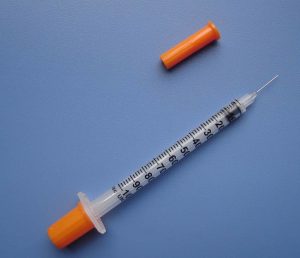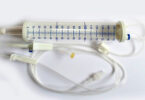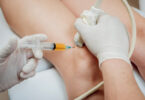Insulin is administered in the subcutaneous tissue, located between the skin and the muscle, where it is deposited and from where it is slowly absorbed. Avoid injecting insulin inside the skin (intradermal injection), as it is very painful. It should also be avoided injecting into the muscle, because it changes the speed of absorption of insulin, which increases the glycemic variability and leads to more hypoglycemia and unexplained hypoglycemia.
The most common way to inject insulin is with a syringe. This type of injection is called subcutaneous tissue injection or subcutaneous injection.
To ensure an adequate insulin injection, several factors must be taken into account:
- Choose the appropriate puncture zones and establish a good pattern of rotation of zones.
- Avoid injecting in areas with lipodystrophy and scars.
- Take skin fold or pinch with the index finger and thumb in an appropriate manner.
- Count 10 seconds after injecting the insulin, in order to wait a reasonable time before removing the needle and avoid refluxing the insulin.
- Choose a needle of adequate length.
- Avoid the reuse of needles.
Syringes come in different sizes. Over time syringes have changed both the length and the thickness of the needles, which have led to the modification of the criteria to choose the right needle. Currently, the following aspects must be taken into account:
- Less thickness, less pain: The least painful needles are those that are 31G and 32G thick.
- Adapt the insulin needle to the thickness of the skin: The skin of children is slightly less thick than that of adults. In very thin and young people, intramuscular injections occur more frequently if long needles are used. Therefore, the shortest needles in the market today, 4 mm in length, reliably cross the skin of all people, both children and adults, so that insulin reaches the subcutaneous fat without problems.
- Shorter needles are much safer, better tolerated and less painful.
- Suitable needles should measure a maximum of 6 mm in length.
- The shortest length for pen or pen is 4 mm and the syringe length is 6 mm, as it must pass through the cap of the insulin vial.
- The pain felt by people who inject insulin depends on the dose of insulin, the injection site, the amount of fatty tissue under the skin, and other factors. Many patients prefer small needles, because they seem more comfortable. Even so, many other people prefer the long needle because it feels more comfortable.
- Syringes are the most common method for insulin injection because of many advantages.
- Syringes are the cheapest way to inject insulin, they are easy to use and learning how to use them is also very easy.
- If you need to inject two types of insulin, you can mix them in the same syringe and they come in different sizes, with different lengths and needle widths. They are also safe and have few moving parts.
 It is important when disposing insulin syringes, take into account the following to do so safely:
It is important when disposing insulin syringes, take into account the following to do so safely:
- Cut off the needle of the syringe so that nobody else can use it, but do not use scissors, as the needle can fly off and hurt someone or get lost.
- You can use devices with caps for the needles.
- There may be regulations in place to dispose of medical waste.
- When you travel, take your used syringes home. To transport them, pack them in a sturdy container so that the needle cannot pierce.
As simple as these tips, is to acquire our services. Get to know your new Pharmamedic digital medical center.









